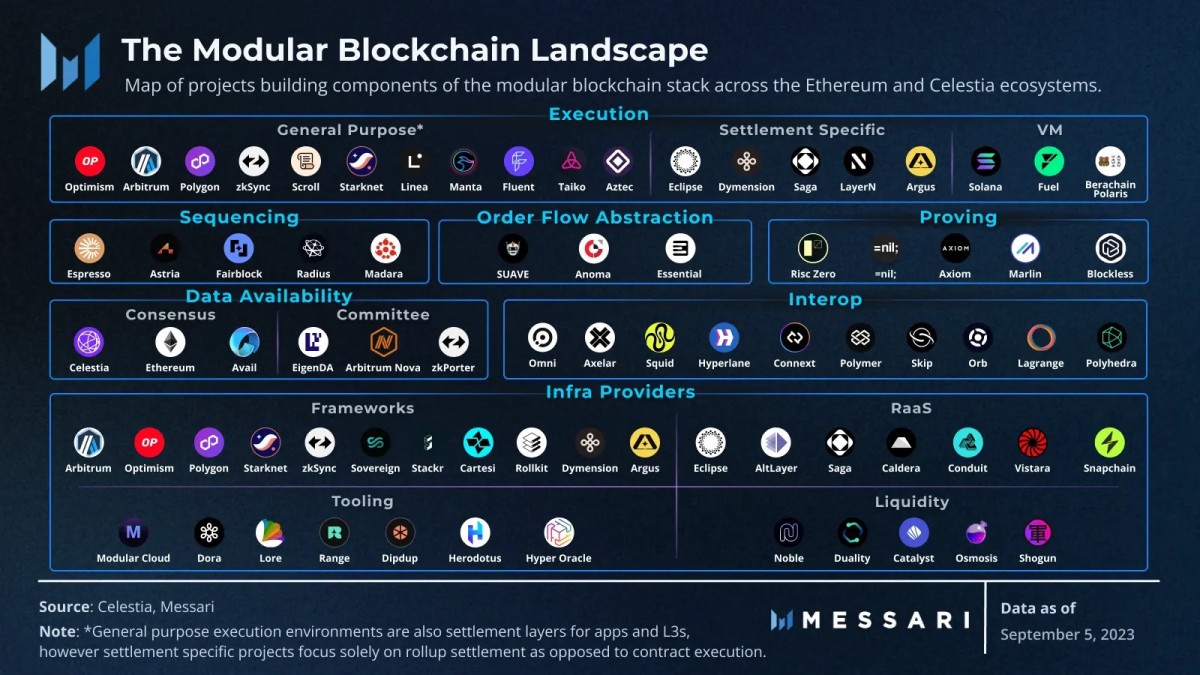First of all, what is modularity?
Modularity is the result of an interesting experiment conducted on Ethereum as a reaction to the poor scaling properties of blockchains. To solve this bottleneck, developers took the bold approach of auctioning off core functionality of the main chain to other blockchains.
This modular transformation around rollup technology has completely redefined how products and services can be built on Ethereum. By breaking down each element of the stack, different architectures can be designed depending on the use case. Not surprisingly, this has led to an explosion of blockchain.
No kidding, everyone is selling blockchain again and getting super rich.

Each new consensus protocol offers new and interesting scaling opportunities, but also strange coordination problems: how do we make the economy efficient when users are distributed across different networks? How do we keep everyone in sync across this distribution? Is there yet another blockchain?
Turtles everywhere.
The fragmentation of the ecosystem has had some obvious consequences. First, users are siloed and trapped between intermediaries. While rollups have powerful trust-minimizing properties, the inefficiencies created by transfers into and out of these systems impose unjustified costs on users. They also expose them to riskier options such as bridges and centralized services.
For developers, the lack of interoperability between platforms creates friction and fosters a competitive rather than collaborative environment. New protocols are created every other day, with new and existing teams competing for different copies of the same application. Often, teams choose to “bet on themselves” and spin off into their own ecosystem (blockchain). It is important to highlight the appeal of this model, which allows you to customize and optimize different components of each application. This flexible architecture allows everyone to contribute their own frameworks to inspire new designs. The possibilities are endless.
Unfortunately, these incentives lead to fragmented network effects: when nothing works, users consolidate into a few competing networks, which results in economic activity being concentrated in fewer permissioned systems.
This modularization has led people away from the goal when it shouldn’t have. Using different interfaces to interact with a consensus protocol is a perfectly valid idea. But Ethereum’s strategy is problematic: it treats interoperability as an optional feature, rather than a fundamental design principle. As Ethereum continues to push for scalability by adding more blockchains, the debate will continue. There are ample opportunities for competitors to exploit these fragmentations and foment discord: divide and conquer.
Bitcoin Opportunity
With Bitcoin, a different architecture has emerged with a fundamentally different design. With Lightning as the backbone for interoperability, developers are slowly uniting towards a technology stack that is much closer to Bitcoin’s peer-to-peer model.
Protocols like Cashu and Fedimint optimize for local, permissionless interactions rather than trying to replicate a global shared state. Financial services are deployed in different economic hubs and remain connected through the Lightning Network.
Liquidity providers, atomic bridge, ecash mint. A new financial network that all share the same settlement layer.
Enter Nostr, the social abstraction that ties it all together. A social network based on similar principles to Bitcoin, it offers a simple set of rules designed to maximize interoperability. By avoiding being prescriptive about what it does, Nostr allows for a more flexible and scalable world. Cambrian Explosion Open innovation.
Today, various projects are beginning to explore how Nostr can facilitate Bitcoin commerce by making it a native component of the Bitcoin user experience. The protocol’s underlying public key infrastructure blends naturally with wallets and other payment applications, allowing them to communicate with each other and securely exchange messages. This communication layer can connect users to other users using the various services available through the network. Nostr Wallet Connect making New Opportunities It enables Bitcoin applications to connect with Nostr’s growing ecosystem.
Case Study
Projects like Rebellion This perfectly embodies the difference in Bitcoin’s modular vision. Users can use the Nostr Relay, the Fedimint Federation, Lightning Service Provider (LSP)Each of these grants access to an increasing number of features and applications. Using Nostr as a discovery service, we can leverage our social networks to identify and natively access applications and services recommended by our peers. This web of trust brings an interesting alternative to so-called trustless systems: participants can start relying on market incentives to make more efficient transactions that are not bound by the trade-offs required in a more decentralized system.
Ultimately, liquidity providers, electronic cash mints, lenders, and CoinJoin Coordinator We will be promoting our services through Nostr. Civkit, a decentralized order book project, seamlessly integrates with Mutiny to allow users to participate in peer-to-peer transactions. All integrations are designed around permissionless participation, allowing users to maintain full sovereignty over their interactions.
Platforms and Protocols
Bitcoin’s modularization is not without risks. Fundamental pieces of the puzzle such as LSPs come with large capital requirements that create economies of scale among competing providers. EcashMint’s growth could be hampered by regulatory concerns or operator fraud. Nostr Relay is already Tendency towards centralization It remains unclear how the network topology will evolve.
The success of this approach relies on market choice, and it is essential that the barriers to entry for these businesses are low. There are a number of initiatives underway to achieve this. For example, several Lightning companies are currently working together to specification This allows any market participant to implement their own LSP.
It is probably too early to predict how these architectures and protocols will evolve. As both worlds continue to collide, it is likely that rollups will establish their place within the Bitcoin ecosystem. zk coin It doesn’t require global state and has the potential to be interoperable with Lightning.
The tension between both approaches is reminiscent of the early days of the Internet. Commercial interests may favor platforms that can capture and monetize some of the network effects. More open, permissionless protocols may take longer to really take off. The Internet provides a cautionary example when it comes to consolidating services and applications into gatekeeping walled gardens. Hopefully, Bitcoin’s current development path will resolve into a future that prioritizes interoperability and permissionless access over financial silos.







